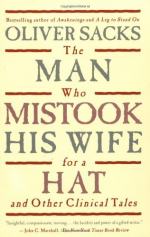|
This section contains 691 words (approx. 2 pages at 400 words per page) |

|
The Man Who Mistook His Wife for a Hat and Other Clinical Tales Summary & Study Guide Description
The Man Who Mistook His Wife for a Hat and Other Clinical Tales Summary & Study Guide includes comprehensive information and analysis to help you understand the book. This study guide contains the following sections:
This detailed literature summary also contains Topics for Discussion and a Free Quiz on The Man Who Mistook His Wife for a Hat and Other Clinical Tales by Oliver Sacks.
Oliver Sacks is a professor of clinical neurology who has spent years seeing patients. He has compiled some of his more interesting, more personal stories into one volume to share with the world. His goal in writing the book is to present the personal side of neurosis. Often books of this sort are written as a series of case studies full of medical terminology that leaves the average reader frustrated and unwilling to finish the book. Sacks mixes his clinical jargon with a personal empathy for his patients, drawing the reader in and allowing even the most inexperienced reader to gain a better understanding of the lives of the mentally disabled.
Sacks divides his book into four separate but somewhat intertwining parts. Just as many neurological diseases are not mutually exclusive, neither are the stories Sacks compiles. In each section, Sacks highlights several stories of patients suffering from a disease corresponding to the section heading. There are stories of mental losses, mental excesses, mental transports, and the world of the simple.
In the section focusing on losses, the reader is introduced to several interesting people who suffer similar disorders and each cope with their imposed lifestyle in a different way. Dr. P. is able to continue living his life nearly as normally as before the onset of his disease. In fact he is able to adapt his lifestyle to include his disease in a manner that benefits him and his interests. Jimmie G. on the other hand is lost in a world of the past and will never be able to catch up with those around him. For Jimmie G. the world stands still in 1945 and all attempts to bring him up-to-date cause frustration for both him and his doctors. Christina is trying to live a normal life but when she suddenly finds herself without a body she is forced to face herself and her problems. These are just a few of the people the reader finds in Part One and the reader discovers just how quickly and inexplicably a life can change.
Part Two features patients with excesses. Witty Ticcy Ray is possibly the most memorable person from this section. Ray suffers from Tourette's syndrome but suffers is not quite the right word when discussing Ray. Ray has been able to use his syndrome to his advantage in several arenas. He is an excellent drummer because he is prone to lash out into a wild solo and he is wildly entertaining because of his offbeat wit. However, Ray does need some help harnessing his syndrome in order to function reasonably at home and avoid losing his family.
Part Three discusses people with transports. This concept is a little difficult to grasp at first. Although Sacks gives a lengthy description of transports at the start of the section, it is not until the reader reaches the stories of Mrs. O' C. and Bhagawhandi that a glimmer of understanding lights up. Mrs. O' C. hears music in her head—Irish music. The music transports her back to a time in her childhood she thought was lost forever. She is able to warmly remember a mother she barely knew and finds a piece of herself finally restored. Bhagawhandi suffers from an inoperable brain tumor but instead of becoming discouraged that her life will end earlier than it should, she finds comfort in the images that eventually overwhelm her. These images transport Bhagawhandi back to her native India even though she is physically unable to make the trip home.
Part Four is perhaps the most moving and interesting section of the entire book. It is almost sad Sacks chose to leave it until the end, except that if he had placed this section first, the reader might have been disappointed by the lackluster stories of the other three sections. Each story in this section focuses on what Sacks terms "a retardate." These patients are considered "simple" by the medical and social worlds but Sacks brings out their individuality and personal strengths. These stories truly are "stories" and the reader becomes quickly immersed in the lives of these extraordinary patients.
Read more from the Study Guide
|
This section contains 691 words (approx. 2 pages at 400 words per page) |

|



